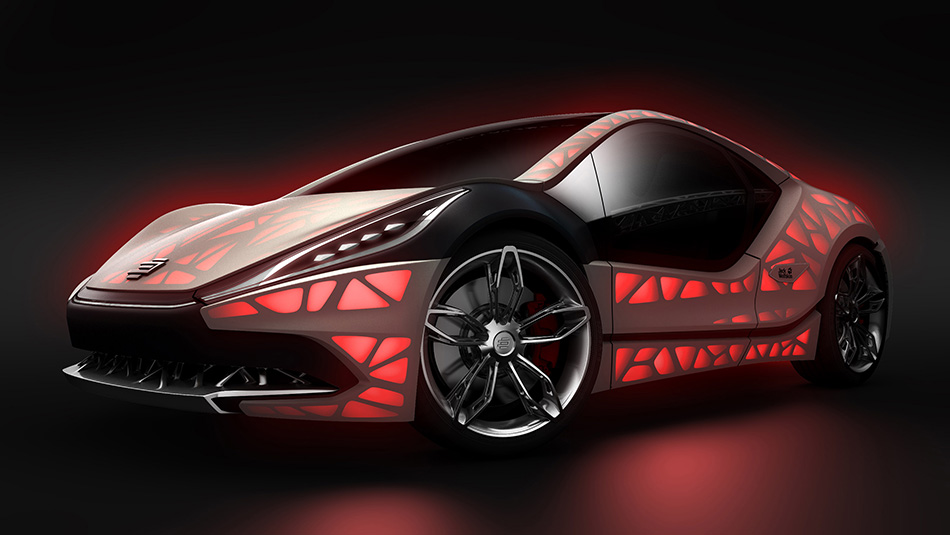The 'EDAG Light Cocoon' is a visionary approach towards a compact, dynamic sports car, with a fully bionically optimised, additively manufactured vehicle structure combined with a weatherproof textile outer skin panel. That is the technical side. The result is a conscious break with existing paradigms. The 'EDAG Light Cocoon' has a pola-rising effect, and the idea is for it to rearrange existing thought patterns in vehicle design. For this unusual and visionary concept, EDAG built up a partnership with outdoor specialists Jack Wolfskin. Their extremely lightweight outdoor textile 'Texapore SOFTSHELL O2+' pro-vides ideal weather protection for the 'EDAG Light Cocoon'. LED lighting technology installed behind the textile outer skin panel makes the vehicle's skele-ton-like, organic structure visible, highlighting the vehicle's new, independent look to perfection.
Following the success of the EDAG GENESIS last year, EDAG have expanded their vision of a bionically inspired body structure. "We are pursuing the vision of sustainability – as demonstrated by nature: lightweight, efficient, without any waste, and with a result that weighs considerable less" explains EDAG's head designer, Johannes Barckmann. When the 'EDAG Light Cocoon' was being designed, its body was not regarded as a closed surface. Instead, an approach was adopted in which material was only actually used in areas where it was necessary for function, safety and stiffness.

"The result is the 'EDAG Light Cocoon': a stable, branch-like load bearing structure which meets all requirements imposed on structurally relevant components, despite the fact that less material has been used," adds Johannes Barckmann. To first of all quantify and then verify the lightweight potential of a bionically designed structure, this approach had previously been used in the design of the bonnet of a production vehicle, and then calculated. It goes without saying, of course, that in extremely lightweight concepts of this type any requirements regarding torsional and flexural stiffness and pedestrian protection must be met. The ensuing result was a spider-like, hollow structure designed for an assembly of aluminium profiles of different thicknesses. The calculation results confirmed two things: that the stability requirements were met, and that a weight saving of approx. 25 % was achieved with this bonnet.
The EDAG designers took nature as their inspiration for the ultimate, lightweight outer skin. The leaf of a plant served as the blueprint for the innovative design of the body shell. Just like the structure of a leaf, which has a lightweight outer skin stretched over it, a lightweight protective skin covers the 'EDAG Light Cocoon' – though in this case, it is made of a textile fabric. In Jack Wolfskin, outdoor specialists, the ideal project partner was found to supply a tried and tested stretch fabric that is also extremely weatherproof, to serve as the new outer body skin. "For us, the fascinating thing about the 'EDAG Light Cocoon' is the combination of two technological innovations – the vehicle structure, fully bionically optimised by EDAG, and the lightweight Jack Wolfskin TEXAPORE SOFTSHELL O2+ weather protection material," explained Elke Stein, Jack Wolfskin's Director of Marketing. "We see this as a chance to make an innovative mark beyond the limits of the outdoor sector – and EDAG is the perfect partner here."
TEXAPORE SOFTSHELL O2+ is a triple-layered polyester jersey fabric, which is extremely lightweight, durable and watertight. The material's excellent elasticity is what qualified it for the bionic structure of the 'EDAG Light Cocoon', as it can provide a perfect fit und accentuate it to perfection. Thanks to an LED back light concept, the interaction between light, structure and fabric created an attractive - and above all - innovative vehicle design. "Even if it sounds futuristic to begin with, this approach has its own special appeal: weighing no more than 19 g/m², the Jack Wolfskin materials support maximum lightweight design requirements with minimum weight. TEXAPORE Softshell, which is what we use, weighs just 154 g/m², making it one of the lightest TEXAPORE materials on offer," comments EDAG CEO Jörg Ohlsen. "Combined with the bionically inspired, 3D-printed structure, it offers enormous potential and stimulus for the ultimate lightweight construction of the future."
Source: EDAG












